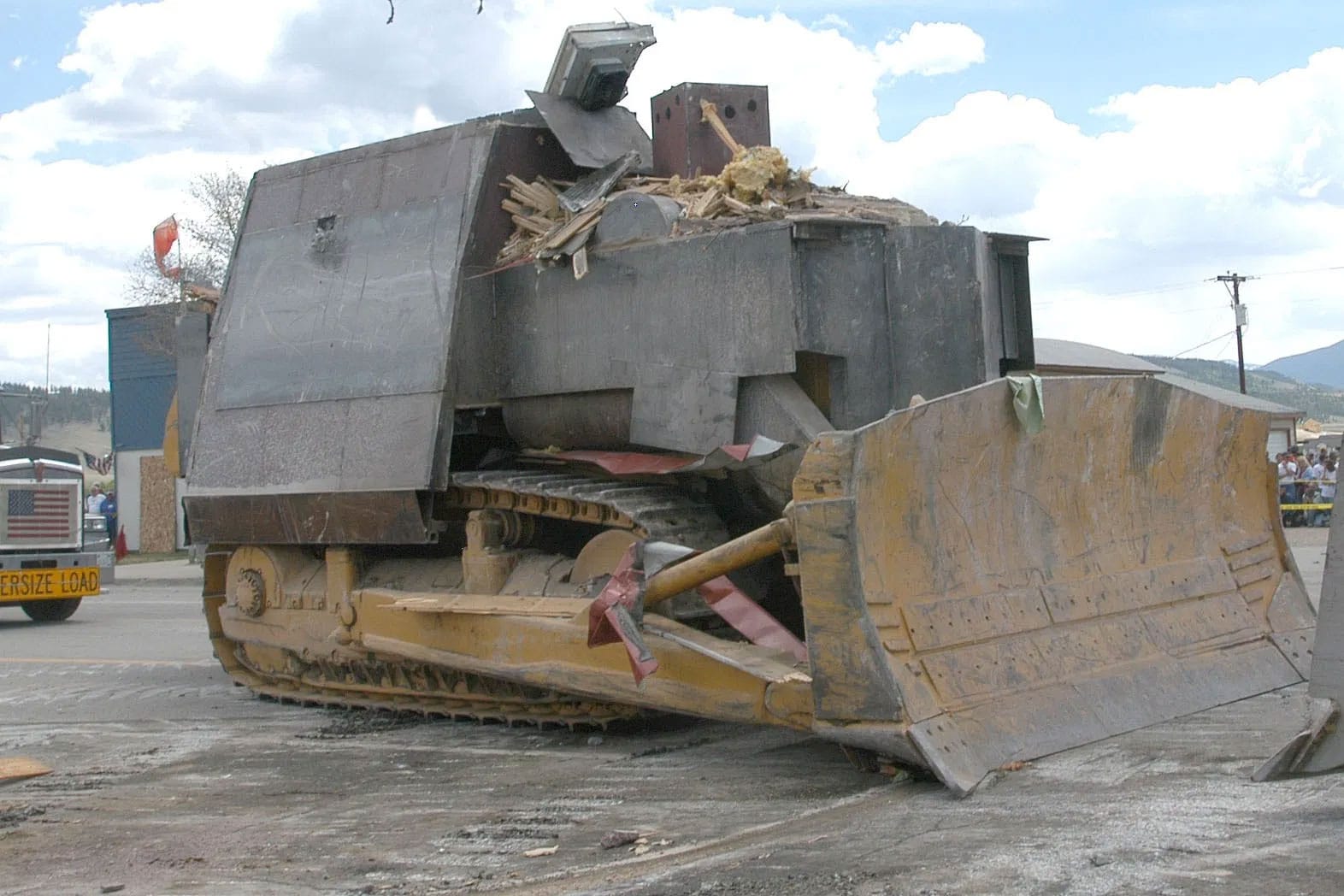This isn’t just about a bulldozer; it’s about the Killdozer, an internet phenomenon born from a real-life tragedy. This article explores the multifaceted journey of Marvin Heemeyer’s 2004 rampage in Granby, Colorado, from its destructive origins to its bizarre afterlife as a darkly humorous meme. We’ll examine the incident, its memeification, the online communities it spawned, and the ethical questions it continues to raise. Buckle up—it’s a wild ride.
The Genesis of a Rampage: From Grievance to Granby’s Ground Zero
The Killdozer story begins with a man named Marvin Heemeyer, a welder and muffler shop owner in Granby, Colorado. Heemeyer became embroiled in a bitter dispute with the town council over zoning permits and fines related to his business. Specifically, he was fined for violating city ordinances by dumping sewage on his property, a consequence of being denied access to the sewer line. He also clashed with the town over the approval of a concrete batch plant near his property. [https://www.lolaapp.com/nine-of-pentacles-reversed] Heemeyer attempted to fight these decisions through legal channels, but he felt increasingly ignored and wronged by the system. This simmering frustration would eventually boil over, leading to devastating consequences.
Over two years, fueled by his perceived injustices, Heemeyer meticulously transformed a Komatsu D355A bulldozer into an armored behemoth. [https://www.lolaapp.com/judgement-tarot-reversed] Layers of steel and concrete, impervious to small arms fire, encased the machine. He installed cameras for visibility, gun ports (though he never fired them at individuals), and even air conditioning. This was not a spontaneous act; it was a calculated transformation driven by a deep-seated rage.
On June 4, 2004, Granby’s tranquility shattered. For two hours and seven minutes, the Killdozer tore through the town, targeting the buildings Heemeyer associated with his grievances: the town hall, the former mayor’s home, a hardware store owned by a former council member, the local newspaper office, and the concrete plant. Thirteen buildings ultimately fell victim to Heemeyer’s destructive path. Miraculously, despite the extensive damage, no one other than Heemeyer was killed or injured. Heemeyer’s rampage culminated in the Killdozer becoming immobilized in the basement of a Gambles hardware store, where he took his own life.
The Digital Afterlife: From Rampage to Meme
The Killdozer incident, with its bizarre visuals and dramatic narrative, was primed for virality in the burgeoning internet age. Images and videos of the rampage quickly spread, the name “Killdozer” itself contributing to its memetic potential. The internet, with its penchant for dissection and debate, grappled with Heemeyer’s motivations. Was he a righteous rebel fighting the system, a victim driven to the brink, or simply a dangerous individual who took the law into his own hands? This ambiguity fueled online fascination, transforming a real-world tragedy into a complex and often contradictory meme.
Evolving Interpretations: From Villain to Vigilante?
The Killdozer meme’s meaning has shifted over time. Initially, the focus was on the destruction and the audacity of Heemeyer’s actions. He was largely condemned as a villain. However, a different narrative began to emerge in some corners of the internet. Heemeyer, the villain, was gradually recast as a sort of anti-hero, a symbol of resistance against perceived government overreach and bureaucratic incompetence. Dark humor and ironic detachment became the dominant lenses through which the incident was viewed. Memes portraying Heemeyer as a folk hero, a champion of the little guy, began to proliferate. This wasn’t necessarily an endorsement of his violent methods, but perhaps a reflection of online cynicism, a distrust of authority, and a perverse fascination with the chaos he unleashed.
Online Ecosystems: Communities and Conversations
As the Killdozer meme evolved, dedicated online communities flourished. Subreddits like r/KilldozerMemes became hubs for sharing and creating Killdozer-related content. Imageboards, forums, and social media platforms amplified its reach. These communities aren’t solely about celebrating destruction; they are spaces where people explore the complexities of the event, debate its meaning, and engage in the dark humor that often pervades online culture. The enduring appeal of the Killdozer meme likely stems from a combination of factors: the power fantasy it represents, a vicarious thrill experienced from behind a keyboard, and perhaps a deeper resonance with feelings of powerlessness against bureaucratic systems.
The Ethical Minefield: Humor, Tragedy, and the Internet’s Responsibility
The Killdozer meme’s longevity raises uncomfortable ethical questions. Where is the line between dark humor and insensitivity? What does it mean when we find amusement in an act of destruction, even one that occurred years ago? The memefication of a tragedy, the transformation of a real-world event with real-world consequences into something shareable, remixable, and even laughable, demands careful consideration.
Granby’s Scars: Remembering the Real-World Impact
While the Killdozer meme thrives in the digital realm, it casts a long shadow over Granby, Colorado. The town still bears the scars, both physical and emotional, of that day. The meme serves as a constant reminder of the day a man and his machine became an internet sensation. How does a community navigate this unusual legacy? How do they reconcile the tangible devastation with its abstract, often flippant online representation? It’s a complex and ongoing process.
Decoding the “Killdozer Quote”: Actions Speak Louder Than Words
There’s no single, iconic quote from Marvin Heemeyer during the Killdozer rampage. The idea of a catchphrase likely arises from the perceived statement inherent in his destructive actions. The Killdozer itself became the quote, a roaring, metal embodiment of frustration. However, Heemeyer did leave behind audio recordings detailing his motivations and frustrations. These recordings, while disturbing, offer a glimpse into his mindset and the justifications he constructed for his actions. They reveal a man consumed by his perceived injustices, driven to extremes. The absence of a pithy quote makes the meme even more intriguing. The meaning is left open to interpretation. For some, it symbolizes rebellion against authority; for others, it’s a cautionary tale. And for some, it remains simply a source of dark humor.
Killdozer!: From Sci-Fi Flick to Unintentional Precursor
The name “Killdozer” predates the 2004 incident. A 1974 made-for-TV movie, based on a 1944 novella by Theodore Sturgeon, bears the same name. This Killdozer! features a construction crew on a remote island battling a bulldozer possessed by an alien force. The film gained a cult following, but was largely overshadowed by the real-world events that would later share its name. The convergence of the fictional and real-world Killdozers creates a fascinating intersection of media and reality. One is a cautionary tale about technology, the other a tragic display of human anger and desperation.
June 4, 2004: “Killdozer Day” and its Lasting Resonance
June 4th is the date etched in Granby’s memory. This is the day Heemeyer unleashed his creation. The “Killdozer” incident, now a meme, transformed a tragedy into a spectacle. But the meme’s meaning remains complex and contested. Is it dark humor? A cautionary tale? A symbol of rebellion? There’s no single answer. Some online communities even “commemorate” June 4th as “Killdozer Day,” further blurring the lines between remembrance and macabre fascination.
The Killdozer incident, and the meme it spawned, continues to evoke discussion and even inspire ongoing research into the psychological motivations behind such extreme acts. While we may never fully understand the complexities of human behavior, the Killdozer phenomenon serves as a stark reminder of the destructive potential of unresolved conflict and the internet’s power to shape and distort narratives. The Killdozer isn’t just pixels and jokes; it’s a digital scar on a real community and a lasting testament to the unpredictable nature of online culture.
- Discover White Fruits: Ultimate Guide to Taste & Nutrition - April 8, 2025
- Read Wonderful New World: Korean Manhwa Hit - April 8, 2025
- Discover Japanese Drawings: A Complete Guide - April 8, 2025
















